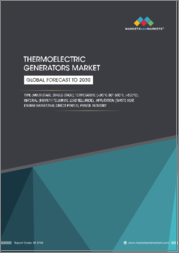
|
시장보고서
상품코드
1675334
자동차용 열전발전기 시장 : 컴포넌트별, 재료별, 차종별, 애플리케이션별, 지역별(2025-2033년)Automotive Thermoelectric Generator Market Report by Component, Material (Magnesium Silicide, Bismuth Telluride, Lead Telluride, Skutterudite), Vehicle Type, Application, and Region 2025-2033 |
||||||
세계의 자동차용 열전발전기 시장 규모는 2024년에 4,970만 달러에 달했습니다. 향후 IMARC Group은 2033년까지 시장이 1억 2,220만 달러에 달하며, 2025-2033년에 9.98%의 성장률(CAGR)을 보일 것으로 예측하고 있습니다. 저연비차에 대한 요구의 증가가 시장을 자극하고 있습니다.
자동차 열전발전기는 제벡 효과를 이용하여 내연기관(ICE)의 폐열을 전기에너지로 변환하는 장비입니다. 열교환기, 냉각판, 압축 어셈블리 및 비스무스 텔루르화 비스무트(Bi2Te3), 납 텔루르화 납(PbTe), 스컬터다이트, 규화마그네슘 등의 열전 재료로 구성됩니다. 자동차 열전발전기는 인포테인먼트, 에어컨, 조명, 소형 냉장고 등 자동차의 다양한 시스템에 전력을 공급하기 위해 널리 사용되고 있습니다. 버려지는 열에너지를 재사용하고, 연료 소비를 줄이고, 운전 비용을 최소화하며, 차량의 전동화를 지원하는 비교적 간단한 시스템입니다. 또한 자동차 열전발전기는 친환경적이고 가볍고, 유지보수가 간편하며, 소음과 진동을 발생시키지 않는 장점이 있습니다.
자동차 열전발전기 시장 동향 :
저연비 차량에 대한 수요 증가는 시장 성장을 가속하는 주요 요인 중 하나입니다. 자동차 열전발전기는 연료 소비를 줄이고 효율성을 향상시키기 위해 승용차 및 상용차에 널리 사용되고 있습니다. 또한 발전기의 부하를 대체하고, 엔진 및 변속기의 예열을 가속화하고, 추가 질량을 최소화하고, 냉각수, 오일, 변압기 유체 펌프 등 자동차의 선택된 기계적 기능을 전기 부품으로 변환합니다. 또한 이산화탄소(CO2) 배출을 줄이고 냉각 시스템에서 냉매 사용을 최소화하기 위해 환경 문제 증가로 인한 제품의 광범위한 사용이 시장 성장을 가속하고 있습니다. 이와는 별도로, 여러 정부가 엄격한 배출 정책을 시행하고 있는 것도 성장을 가속하는 요인으로 작용하고 있습니다. 또한 최근 자동차 박막 열전발전기의 개발 동향은 효율성 향상, 확장성, 비용 효율성, 재료 낭비 감소를 실현하여 시장 성장에 긍정적인 영향을 미치고 있습니다. 기타 요인으로는 하이브리드 및 전기자동차(H/EV)의 제품 채택 증가, 광범위한 연구개발(R&D) 활동, 기존 차량의 급속한 전기화, 소비자의 지출 능력 증가 등이 시장 개발의 원동력이 될 것으로 예상됩니다.
이 보고서에서 다룬 주요 질문
- 세계 자동차 열전발전기 시장 규모는?
- 2025-2033년 세계 자동차 열전발전기 시장의 예상 성장률은?
- 세계 자동차 열전발전기 시장을 주도하는 주요 요인은 무엇인가?
- COVID-19가 세계 자동차 열전발전기 시장에 미치는 영향은?
- 세계 자동차 열전발전기 시장의 재료별 시장 현황은?
- 세계 자동차 열전발전기 시장의 차종별 시장 현황은?
- 세계 자동차 열전발전기 시장의 주요 지역은?
- 세계 자동차 열전발전기 시장의 주요 기업은?
목차
제1장 서문
제2장 조사 범위와 조사 방법
- 조사의 목적
- 이해관계자
- 데이터 소스
- 1차 정보
- 2차 정보
- 시장 추정
- 보텀업 어프로치
- 톱다운 어프로치
- 조사 방법
제3장 개요
제4장 서론
- 개요
- 주요 업계 동향
제5장 세계의 자동차용 열전발전기 시장
- 시장 개요
- 시장 실적
- COVID-19의 영향
- 시장 예측
제6장 시장 내역 : 컴포넌트별
- 열전모듈
- 냉각 플레이트
- 열교환기
- 기타
제7장 시장 내역 : 재료별
- 마그네슘 실리사이드
- 텔루르화 비스무트(Bi2Te3)
- 텔루르화 납(PbTe)
- Skutterudite
제8장 시장 내역 : 차종별
- 승용차
- 상용차
제9장 시장 내역 : 애플리케이션별
- 폐열 회수
- 에너지수확기술
- 직접발전
- 코제너레이션
제10장 시장 내역 : 지역별
- 북미
- 미국
- 캐나다
- 아시아태평양
- 중국
- 일본
- 인도
- 한국
- 호주
- 인도네시아
- 기타
- 유럽
- 독일
- 프랑스
- 영국
- 이탈리아
- 스페인
- 러시아
- 기타
- 라틴아메리카
- 브라질
- 멕시코
- 기타
- 중동 및 아프리카
- 시장 내역 : 국가별
제11장 SWOT 분석
- 개요
- 강점
- 약점
- 기회
- 위협
제12장 밸류체인 분석
제13장 Porter's Five Forces 분석
- 개요
- 바이어의 교섭력
- 공급 기업의 교섭력
- 경쟁의 정도
- 신규 진출업체의 위협
- 대체품의 위협
제14장 가격 분석
제15장 경쟁 구도
- 시장 구조
- 주요 기업
- 주요 기업의 개요
- Coherent Corp.
- European Thermodynamics Ltd.
- Ferrotec(USA) Corporation(Ferrotec Holdings Corporation)
- Laird PLC
- SANGO Co. Ltd.
- Thermonamic Electronics(Jiangxi) Corp. Ltd.
- Yamaha Corporation
The global automotive thermoelectric generator market size reached USD 49.7 Million in 2024. Looking forward, IMARC Group expects the market to reach USD 122.2 Million by 2033, exhibiting a growth rate (CAGR) of 9.98% during 2025-2033. The inflating need for fuel-efficient vehicles is stimulating the market.
An automotive thermoelectric generator is a device that transforms the waste heat of an internal combustion engine (ICE) into electrical energy using the Seebeck effect. It contains heat exchangers, cooling plates, compression assembly, and thermoelectric materials, such as bismuth telluride (Bi2Te3), lead telluride (PbTe), skutterudite, and magnesium silicide. An automotive thermoelectric generator is widely used to power various systems of the vehicle, such as infotainment, air conditioning, lighting, and small refrigerators. It is a relatively simple system that recycles wasted heat energy, reduces fuel consumption, minimizes operating costs, and supports vehicle electrification. An automotive thermoelectric generator is also eco-friendly and lightweight, requires low maintenance, and doesn't generate noise or vibrations.
Automotive Thermoelectric Generator Market Trends:
The increasing demand for fuel-efficient vehicles is one of the primary factors driving the market growth. An automotive thermoelectric generator is widely used in passenger and commercial vehicles to reduce fuel consumption and improve efficiency. It also replaces the generator load, provides faster warm-up of the engine and transmission, minimizes added mass, and converts selected mechanical functions of the vehicles into electrical parts, such as coolant, oil, and trans fluid pumps. Furthermore, the extensive product utilization due to the rising environmental concerns, as they reduce carbon dioxide (CO2) emissions and minimize the use of refrigerants in cooling systems, is favoring the market growth. Apart from this, the implementation of stringent emission policies by several governments is acting as another growth-inducing factor. Additionally, the recent development of thin film thermoelectric generators for automotive applications that provide enhanced efficiency, scalability, cost-effectiveness, and reduced material wastage is positively influencing the market growth. Other factors, including increasing product adoption in hybrid and electric vehicles (H/EVs), extensive research and development (R&D) activities, rapid electrification of existing vehicles, and rising expenditure capacities of consumers, are anticipated to drive the market growth.
Key Market Segmentation:
Breakup by Component:
- Thermoelectric Module
- Cooling Plates
- Heat Exchangers
- Others
Breakup by Material:
- Magnesium Silicide
- Bismuth Telluride (Bi2Te3)
- Lead Telluride (PbTe)
- Skutterudite
Breakup by Vehicle Type:
- Passenger Cars
- Commercial Vehicles
Breakup by Application:
- Waste Heat Recovery
- Energy Harvesting
- Direct Power Generation
- Co-generation
Breakup by Region:
- North America
- United States
- Canada
- Asia-Pacific
- China
- Japan
- India
- South Korea
- Australia
- Indonesia
- Others
- Europe
- Germany
- France
- United Kingdom
- Italy
- Spain
- Russia
- Others
- Latin America
- Brazil
- Mexico
- Others
- Middle East and Africa
Competitive Landscape:
The competitive landscape of the industry has also been examined along with the profiles of the key players being Coherent Corp., European Thermodynamics Ltd., Ferrotec (USA) Corporation (Ferrotec Holdings Corporation), Laird PLC, SANGO Co. Ltd., Thermonamic Electronics (Jiangxi) Corp. Ltd. and Yamaha Corporation. Kindly, note that this only represents a partial list of companies, and the complete list has been provided in the report.
Key Questions Answered in This Report
- 1.How big is the global automotive thermoelectric generator market?
- 2.What is the expected growth rate of the global automotive thermoelectric generator market during 2025-2033?
- 3.What are the key factors driving the global automotive thermoelectric generator market?
- 4.What has been the impact of COVID-19 on the global automotive thermoelectric generator market?
- 5.What is the breakup of the global automotive thermoelectric generator market based on the material?
- 6.What is the breakup of the global automotive thermoelectric generator market based on the vehicle type?
- 7.What are the key regions in the global automotive thermoelectric generator market?
- 8.Who are the key players/companies in the global automotive thermoelectric generator market?
Table of Contents
1 Preface
2 Scope and Methodology
- 2.1 Objectives of the Study
- 2.2 Stakeholders
- 2.3 Data Sources
- 2.3.1 Primary Sources
- 2.3.2 Secondary Sources
- 2.4 Market Estimation
- 2.4.1 Bottom-Up Approach
- 2.4.2 Top-Down Approach
- 2.5 Forecasting Methodology
3 Executive Summary
4 Introduction
- 4.1 Overview
- 4.2 Key Industry Trends
5 Global Automotive Thermoelectric Generator Market
- 5.1 Market Overview
- 5.2 Market Performance
- 5.3 Impact of COVID-19
- 5.4 Market Forecast
6 Market Breakup by Component
- 6.1 Thermoelectric Module
- 6.1.1 Market Trends
- 6.1.2 Market Forecast
- 6.2 Cooling Plates
- 6.2.1 Market Trends
- 6.2.2 Market Forecast
- 6.3 Heat Exchangers
- 6.3.1 Market Trends
- 6.3.2 Market Forecast
- 6.4 Others
- 6.4.1 Market Trends
- 6.4.2 Market Forecast
7 Market Breakup by Material
- 7.1 Magnesium Silicide
- 7.1.1 Market Trends
- 7.1.2 Market Forecast
- 7.2 Bismuth Telluride (Bi2Te3)
- 7.2.1 Market Trends
- 7.2.2 Market Forecast
- 7.3 Lead Telluride (PbTe)
- 7.3.1 Market Trends
- 7.3.2 Market Forecast
- 7.4 Skutterudite
- 7.4.1 Market Trends
- 7.4.2 Market Forecast
8 Market Breakup by Vehicle Type
- 8.1 Passenger Cars
- 8.1.1 Market Trends
- 8.1.2 Market Forecast
- 8.2 Commercial Vehicles
- 8.2.1 Market Trends
- 8.2.2 Market Forecast
9 Market Breakup by Application
- 9.1 Waste Heat Recovery
- 9.1.1 Market Trends
- 9.1.2 Market Forecast
- 9.2 Energy Harvesting
- 9.2.1 Market Trends
- 9.2.2 Market Forecast
- 9.3 Direct Power Generation
- 9.3.1 Market Trends
- 9.3.2 Market Forecast
- 9.4 Co-generation
- 9.4.1 Market Trends
- 9.4.2 Market Forecast
10 Market Breakup by Region
- 10.1 North America
- 10.1.1 United States
- 10.1.1.1 Market Trends
- 10.1.1.2 Market Forecast
- 10.1.2 Canada
- 10.1.2.1 Market Trends
- 10.1.2.2 Market Forecast
- 10.1.1 United States
- 10.2 Asia-Pacific
- 10.2.1 China
- 10.2.1.1 Market Trends
- 10.2.1.2 Market Forecast
- 10.2.2 Japan
- 10.2.2.1 Market Trends
- 10.2.2.2 Market Forecast
- 10.2.3 India
- 10.2.3.1 Market Trends
- 10.2.3.2 Market Forecast
- 10.2.4 South Korea
- 10.2.4.1 Market Trends
- 10.2.4.2 Market Forecast
- 10.2.5 Australia
- 10.2.5.1 Market Trends
- 10.2.5.2 Market Forecast
- 10.2.6 Indonesia
- 10.2.6.1 Market Trends
- 10.2.6.2 Market Forecast
- 10.2.7 Others
- 10.2.7.1 Market Trends
- 10.2.7.2 Market Forecast
- 10.2.1 China
- 10.3 Europe
- 10.3.1 Germany
- 10.3.1.1 Market Trends
- 10.3.1.2 Market Forecast
- 10.3.2 France
- 10.3.2.1 Market Trends
- 10.3.2.2 Market Forecast
- 10.3.3 United Kingdom
- 10.3.3.1 Market Trends
- 10.3.3.2 Market Forecast
- 10.3.4 Italy
- 10.3.4.1 Market Trends
- 10.3.4.2 Market Forecast
- 10.3.5 Spain
- 10.3.5.1 Market Trends
- 10.3.5.2 Market Forecast
- 10.3.6 Russia
- 10.3.6.1 Market Trends
- 10.3.6.2 Market Forecast
- 10.3.7 Others
- 10.3.7.1 Market Trends
- 10.3.7.2 Market Forecast
- 10.3.1 Germany
- 10.4 Latin America
- 10.4.1 Brazil
- 10.4.1.1 Market Trends
- 10.4.1.2 Market Forecast
- 10.4.2 Mexico
- 10.4.2.1 Market Trends
- 10.4.2.2 Market Forecast
- 10.4.3 Others
- 10.4.3.1 Market Trends
- 10.4.3.2 Market Forecast
- 10.4.1 Brazil
- 10.5 Middle East and Africa
- 10.5.1 Market Trends
- 10.5.2 Market Breakup by Country
- 10.5.3 Market Forecast
11 SWOT Analysis
- 11.1 Overview
- 11.2 Strengths
- 11.3 Weaknesses
- 11.4 Opportunities
- 11.5 Threats
12 Value Chain Analysis
13 Porters Five Forces Analysis
- 13.1 Overview
- 13.2 Bargaining Power of Buyers
- 13.3 Bargaining Power of Suppliers
- 13.4 Degree of Competition
- 13.5 Threat of New Entrants
- 13.6 Threat of Substitutes
14 Price Analysis
15 Competitive Landscape
- 15.1 Market Structure
- 15.2 Key Players
- 15.3 Profiles of Key Players
- 15.3.1 Coherent Corp.
- 15.3.1.1 Company Overview
- 15.3.1.2 Product Portfolio
- 15.3.1.3 Financials
- 15.3.2 European Thermodynamics Ltd.
- 15.3.2.1 Company Overview
- 15.3.2.2 Product Portfolio
- 15.3.3 Ferrotec (USA) Corporation (Ferrotec Holdings Corporation)
- 15.3.3.1 Company Overview
- 15.3.3.2 Product Portfolio
- 15.3.4 Laird PLC
- 15.3.4.1 Company Overview
- 15.3.4.2 Product Portfolio
- 15.3.5 SANGO Co. Ltd.
- 15.3.5.1 Company Overview
- 15.3.5.2 Product Portfolio
- 15.3.6 Thermonamic Electronics (Jiangxi) Corp. Ltd.
- 15.3.6.1 Company Overview
- 15.3.6.2 Product Portfolio
- 15.3.7 Yamaha Corporation
- 15.3.7.1 Company Overview
- 15.3.7.2 Product Portfolio
- 15.3.7.3 Financials
- 15.3.7.4 SWOT Analysis
- 15.3.1 Coherent Corp.
Kindly, note that this only represents a partial list of companies, and the complete list has been provided in the report




















